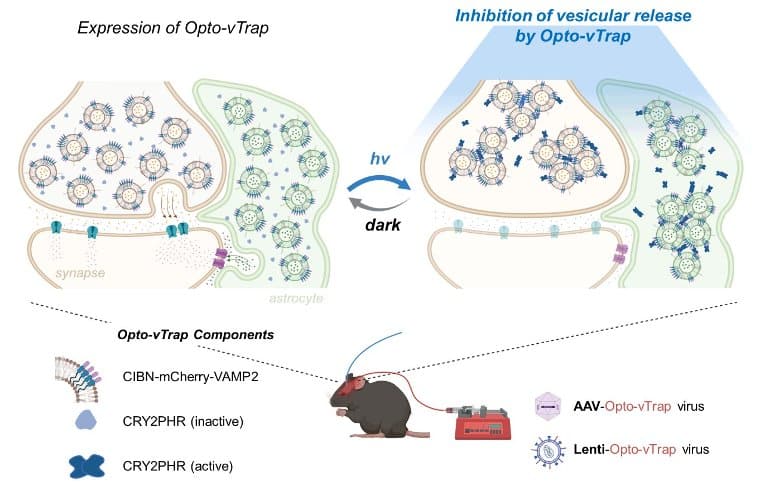Summary: A newly developed system dubbed Opto-vTrap can temporarily trap vesicles from being released from brain cells.
Source: Institute for Basic Science
Controlling signal transmission and reception within the brain circuits is necessary for neuroscientists to achieve a better understanding of the brain’s functions. Communication among neuron and glial cells is mediated by various neurotransmitters being released from the vesicles through exocytosis. Thus, regulating vesicular exocytosis can be a possible strategy to control and understand brain circuits.
However, it has been difficult to freely control the activity of brain cells in a spatiotemporal manner using pre-existing techniques. One is an indirect approach that involves artificially controlling the membrane potential of cells, but it comes with problems of changing the acidity of the surrounding environment or causing unwanted misfiring of neurons. Moreover, it is not applicable for use in cells that do not respond to the membrane potential changes, such as glial cells.
To address this problem, South Korean researchers led by Director C. Justin LEE at the Center for Cognition and Sociality within the Institute for Basic Science (IBS) and professor HEO Won Do at Korea Advanced Institute of Science and Technology (KAIST) developed Opto-vTrap, a light-inducible and reversible inhibition system that can temporarily trap vesicles from being released from brain cells. Opto-vTrap directly targets transmitters containing vesicles, and it can be used in various types of brain cells, even the ones that do not respond to membrane potential changes.

In order to directly control the exocytotic vesicles, the research team applied a technology they previously developed in 2014, called light-activated reversible inhibition by assembled trap (LARIAT). This platform can inactivate various types of proteins when illuminated under blue light by instantly trapping the target proteins, like a lariat. Opto-vTrap was developed by applying this LARIAT platform to vesicle exocytosis. When the Opto-vTrap expressing cells or tissues are shined under blue light, the vesicles form clusters and become trapped within the cells, inhibiting the release of transmitters.
Most importantly, the inhibition triggered using this new technique is temporary, which is very important for neuroscience research. Other previous techniques that target vesicle fusion proteins damage them permanently and disable the target neuron for up to 24 hours, which is not appropriate for many behavioral experiments with short time constraints. By comparison, vesicles that were inactivated using Opto-vTrap decluster in about 15 minutes, and the neurons regain their full functions within an hour.
Opto-vTrap directly controls the signal transmitters’ release, enabling the researchers to freely control brain activity. The research team verified the usability of Opto-vTrap in cultured cells and brain tissue slices. Furthermore, they tested the technique in live mice, which enabled them to temporarily remove fear memory from fear-conditioned animals.
In the future, Opto-vTrap will be used to uncover complex interactions between multiple parts of the brain. It will be a highly useful tool for studying how certain brain cell types affect brain function in different circumstances.
Professor Heo stated, “Since Opto-vTrap can be used in various cell types, it is expected to be helpful in various fields of brain science research,” He explained, “We plan to conduct a study to figure out the spatiotemporal brain functions in various brain cell types in a specific environment using Opto-vTrap technology.”
“The usability of Opto-vTrap can extend not only to neuroscience but also to our lives,” explains Director Lee. He added, “Opto-vTrap will contribute not only to elucidate brain circuit mapping but also epilepsy treatment, muscle spasm treatment, and skin tissue expansion technologies.”
About this neuroscience research news
Author: Press Office
Source: Institute for Basic Science
Contact: Press Office – Institute for Basic Science
Image: The image is credited to Institute for Basic Science
Original Research: Closed access.
“Opto-vTrap, an optogenetic trap for reversible inhibition of vesicular release, synaptic transmission and behavior” by Won Do Heo et al. Neuron
Abstract
Opto-vTrap, an optogenetic trap for reversible inhibition of vesicular release, synaptic transmission and behavior
Highlights
- Opto-vTrap is a quickly reversible optogenetic tool for inhibition of vesicular release
- It is a blue-light-induced vesicle-trapping system based on CRY2 and CIBN interaction
- It shows reversible inhibition of synaptic and gliotransmission and behavior.
- Opto-vTrap can be applied broadly in in vitro, ex vivo, and in vivo models
Summary
Spatiotemporal control of brain activity by optogenetics has emerged as an essential tool to study brain function. For silencing brain activity, optogenetic probes, such as halorhodopsin and archaerhodopsin, inhibit transmitter release indirectly by hyperpolarizing membrane potentials. However, these probes cause an undesirable ionic imbalance and rebound spikes. Moreover, they are not applicable to use in non-excitable glial cells.
Here we engineered Opto-vTrap, a light-inducible and reversible inhibition system to temporarily trap the transmitter-containing vesicles from exocytotic release. Light activation of Opto-vTrap caused full vesicle clusterization and complete inhibition of exocytosis within 1 min, which recovered within 30 min after light off. We found a significant reduction in synaptic and gliotransmission upon activation of Opto-vTrap in acute brain slices. Opto-vTrap significantly inhibited hippocampus-dependent memory retrieval with full recovery within an hour.
We propose Opto-vTrap as a next-generation optogenetic silencer to control brain activity and behavior with minimal confounding effects.






